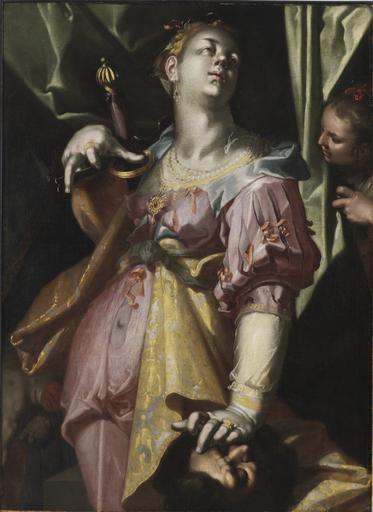MAKE A MEME
View Large Image

| View Original: | Wtewael,_Joachim,_Judith_and_the_Head_of_Holofernes,_ca._1595-1600.jpg (2913x4000) | |||
| Download: | Original | Medium | Small | Thumb |
| Courtesy of: | commons.wikimedia.org | More Like This | ||
| Keywords: Wtewael, Joachim, Judith and the Head of Holofernes, ca. 1595-1600.jpg Artwork Creator Joachim Wtewael Catalogue Entry Wtewael traveled to Italy in his youth and would have known that the Old Testament heroine Judith was a popular subject for Catholic artists from Donatello to Caravaggio For this Dutch Calvinist artist Judith is probably an allegorical symbol of the victory of God ™s chosen people over an enemy … ” …the Dutch Protestants who considered themselves the successors of the Jewish people declared their independence from Spain in 1579 Here Judith dressed in acidic colors with her gown open at the navel holds the sword with which she struck the blow Her splayed fingers are reminiscent of the artificial poses favored by the influential artist ÂBartholomeus Spranger 1546 “1611 The maidÂservant peers at the body as Judith rests a hand on his head and raises her eyes to heaven The purchase of this work marked the beginning of a series of acquisitions of Dutch Mannerist paintings that has made the Museum the richest repository for such works in America and arguably anywhere outside the Netherlands The Museum was thus in the vanguard of the revaluation and study of northern European art around the year 1600 the age of Shakespeare in England an era that has profoundly marked the modern English-speaking world As perhaps the Museum ™s most extreme painting exemplifying the ornamental tendencies of the period Judith and Holofernes has parallels with some of the distortions and displacements in the rhetorical conceits of Elizabethan England and thus enriches our understanding of that culture Gallery Label Not included in the Hebrew and Protestant Bibles because it is considered apocryphal the story of Judith has been variously interpreted in European art During the siege of Bethulia the Jewish widow Judith beguiles the Assyrian commander Holofernes waits until he is incapacitated by drunkenness and cuts off his head The siege is lifted and Bethulia is saved Donatello ™s fifteenth-century bronze sculpture of Judith in Florence ™s main square celebrated her as a severe righteous liberator In the late sixteenth and early seventeenth centuries however Caravaggio and his followers emphasized the lurid aspects of the tale its blend of sex and violence was exploited for voyeuristic appeal or alternatively for a shocking suggestion of symbolic castration A supporter of Holland ™s revolt against Spain 1560s “1609 Wtewael likely saw in Judith ™s triumph an example of God ™s support of a righteous cause Yet the erotic elements here ” Judith ™s brightly colored two-toned gown which offers a glimpse of her navel her thrown-back head and exposed throat ”hold our attention There is perhaps intentional irony in the heroine ™s proffering of her neck the place where she struck Holofernes to our gaze as she sticks a finger in the dead man ™s eye ca 1595 “1600 Oil on canvas Size cm 109 5 80 <br> frame Size cm 128 5 99 6 Institution Princeton University Art Museum European Art object history Robert E Peters by 1966 “75; sale Sotheby ™s New York March 6 1975 lot 89 to Princeton University Art Museum exhibition history credit line Museum purchase gift of George L Craig Jr Class of 1921 and Mrs Craig accession number y1975-11 place of creation Princeton University Art Museum PD-old-100 1638 cite book Steward James Christen Princeton University Art Museum Handbook of the Collections Revised and Expanded Edition 2013 Princeton University Art Museum Princeton NJ 978-0943012414 2nd 191 cite web Judith and the Head of Holofernes y1975-11 http //artmuseum princeton edu/collections/objects/32190 Princeton University Art Museum European art in the Princeton University Art Museum 1595 European paintings in the Princeton University Art Museum 1595 Paintings in the Princeton University Art Museum 1595 Dutch paintings in the Princeton University Art Museum 1595 Renaissance paintings of Judith with the head of Holofernes Joachim Wtewael Uploaded with UploadWizard | ||||